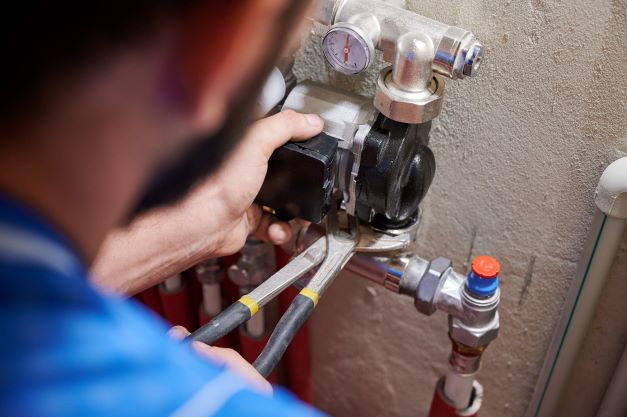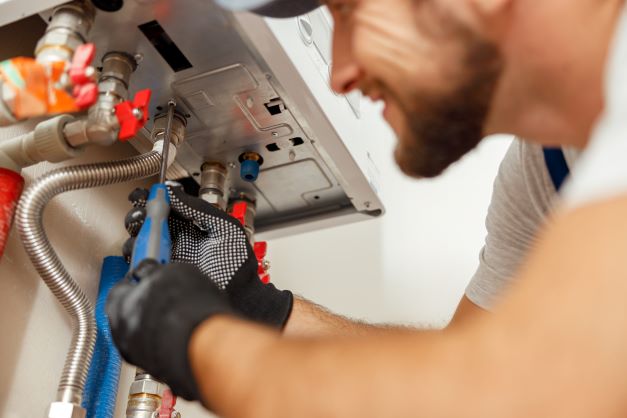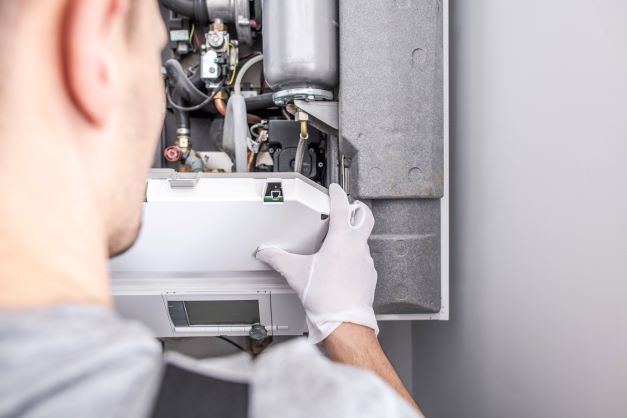There are a lot of different types of heating systems, boilers and plumbing methods out there and it can be quite confusing. Choosing the right system for your home can make all the difference when it comes to keeping your home warm.
The central heating system transfers heat through a network of pipes from the boiler to radiators and the hot water tank. There are two main types: regular / system boilers and combi boilers.
Furnace
Furnaces are one of the most common types of central heating systems used in homes and businesses. They are also very reliable and efficient. They have a long life expectancy and require minimal maintenance if they are properly installed and maintained by qualified professionals.
A furnace consists of six main components: a thermostat, gas valve, burners, heat exchanger, blower, and air ducts. The thermostat controls the flow and temperature of gas to the burners.
Depending on the furnace type, there may be other features that regulate the temperature. For example, some furnaces come with a humidifier to increase the moisture level of the air and a filter that removes dust and debris from the air.
Once the system detects that the temperature is lower than what it is set to on the thermostat, it turns on and starts burning fuel to warm up the home. The process of combustion is what makes the furnace work, and it’s important to keep it safe by regularly changing the filters and checking for a crack in the gas valve or other issues with the flue vent.
The flame from the burners is then transferred to the heat exchanger. This transfers the flame to the furnace’s ductwork, which in turn turns it into air. The air is then heated up and sent to the blower. It’s then distributed through the ductwork to the house.
Modern furnaces can have an automated pilot light that lights up the flame when it is needed. This saves heating fuel that would otherwise have been wasted by a constant burning pilot light.
Another feature that modern furnaces have is AFUE (Annual Fuel Utilization Efficiency). This rating shows how efficient the furnace converts fuel to heat.
The furnace’s performance is directly affected by AFUE. This is the key to getting the best out of your fuel. To maximize your energy savings and reduce your carbon footprint, it is important to have an AFUE of at minimum 90%.
Boiler
A boiler is a type of central heating system that uses a combination of heat and water to heat your home. It works by sending heated water through pipes that connect with radiators located throughout your home.
This process provides a constant source of heat that keeps your home warm year round. It is also a very energy efficient option. Boilers can be used to heat oil, gas, or coal. They can convert this heat into steam and liquid form depending on which type you choose.
A boiler can provide heating for your home at a lower price than other systems. They don’t require a large network heating tubes, which can be costly to replace, and they use a smaller fuel container.
Additionally, they don’t circulate clouds of air pollutants like forced-air systems do, ensuring that your indoor air quality is as healthy as possible. This is important if you have sensitive allergies or asthma or suffer from other health conditions that are aggravated by indoor air pollution.
Many boilers today are equipped with technology that allows you to adjust the intensity of your heating system according to your energy needs. You will save energy by only using it when you really need it. This technology has the potential to revolutionize the way these systems work, reducing your energy costs and significantly changing the way they operate.
Modern boilers can also be programmed to separate heating zones according to room or time of day. This allows for better control over energy consumption and comfort. This is a great feature if you prefer multiple thermostats and greater flexibility in your home’s temperature settings.
Modern boilers are also more reliable than their older counterparts, requiring less maintenance and repairs over the long term. They can last up to 15 years before they start to lose their ability to perform well.
Boilers should be maintained and serviced regularly by an HVAC company, regardless of age. This will ensure that they are efficient and effective. A slow creep upward in your fuel bills or more frequent and expensive repair bills are signs that your boiler is working less efficiently than it once did.

Radiators
Radiators are one of the oldest and most effective ways to heat a building or part of a building. Radiators circulate hot liquid through metal pipes, which convert the heat from the liquid to radiant energy. They can be combined with other heating systems, such as a furnace or boiler, to provide warmth for the entire building.
Radiators are an essential part of a central heating system. They heat up the water from the boiler and transfer it to the rooms in the house. Depending on your system, the type of radiator that you use will determine what kind of radiator you choose.
There are two types of radiators. They are hot-water and steam. The first uses hot water from your furnace to heat the radiators. It then returns the steam to the furnace through a pipe. The second type is referred to as a one-pipe system because there is only one pipe to each radiator.
The most important thing to remember is that you should have a balanced system, which is achieved by controlling how fast your hot water flows through each radiator. The faster it flows through a radiator, the less heat that it can give off.
This can be checked by placing a thermometer in your radiator’s inlet pipe while it heats and then placing it in the outlet pipe when the water has run out. If it drops below 10 degrees Celsius, your radiator is slowing down.
It is also important to ensure your radiators are in good working condition. If they are not, it can cause them to leak and create a lot of knocking noises. Regularly bleed radiators to maintain their good working condition.
Modern radiators have innovative features and technologies that are more efficient than traditional radiators. Many electric radiators come with thermostats, which allow you to program the radiator to meet your needs and decrease your energy consumption.
These benefits can help reduce your household carbon footprint and save you money on your annual energy bill. It is possible to find ecofriendly models that can adapt to different climates, sizes and configurations of rooms. They are therefore suitable for a variety home conditions.
Heat pumps
Heat pumps are an energy-efficient way to provide both heating and cooling to your home. They are also more affordable and less harmful than other systems.
A heat pump functions in the same manner as an air conditioner. It uses a compressor with circulating refrigerant to extract heat and transfer it. It works in a reverse cycle, which allows it to heat and cool your house in the winter and summer.
According to RMI, it is one of the most versatile and multifunctional heating and cooling systems available today. It can be used in place of an air conditioner or furnace to provide year-round comfort for most homes.
It can also be used as a space heater depending on the model. This will provide a backup in colder weather and save you money on gas and electricity. There are different types of heat pumps, including ground-source, geothermal and air-to-water.
The efficiency of a heatpump will vary depending on which type you choose. An air-source heatpump can be as efficient as a gas furnace Energy Star-rated at 2.2 to 4.5x.
Other benefits include lower operating costs, no risk for carbon monoxide leaks and year-round air quality improvements. They also help to dehumidify your home, keeping you healthy and comfortable all year round.
They can be installed in many different ways, from a standard central system to mini-splits that don’t require ductwork. New window units can heat or cool a home.
The COP (Coefficient Of Performance) rating is the most important thing to look for in a heat pump. You want to ensure the heat pump delivers the heat you need at a reasonable price.
Asking for a free estimate from an HVAC contractor or home inspector is another way to determine the right model will help you get an idea of the cost and maintenance required. A warranty that covers the equipment over a set period of time may also be an option.

